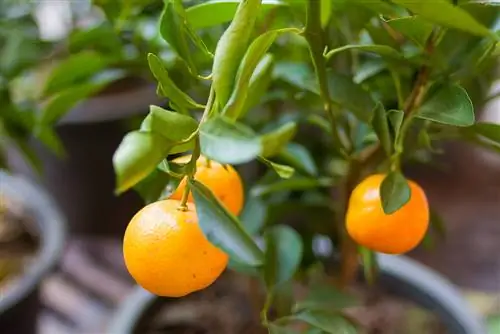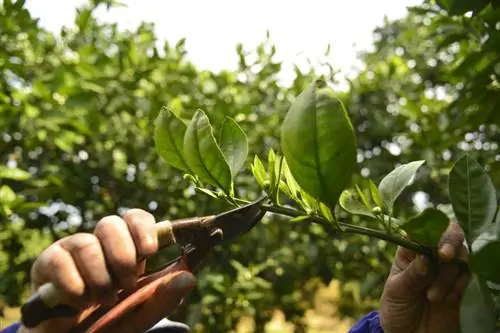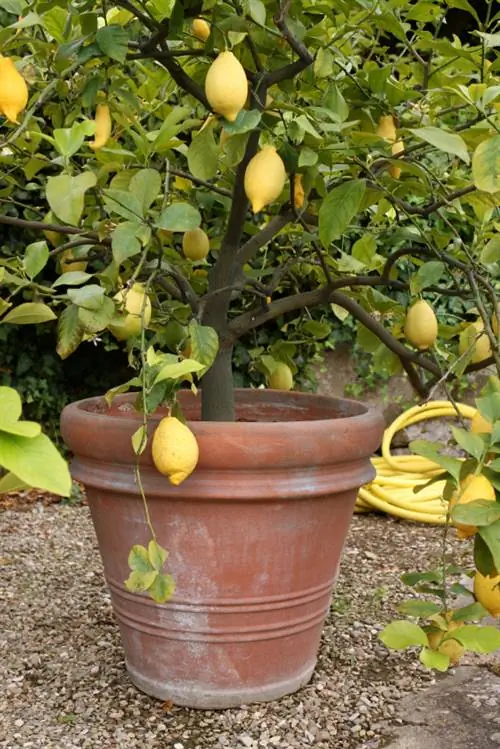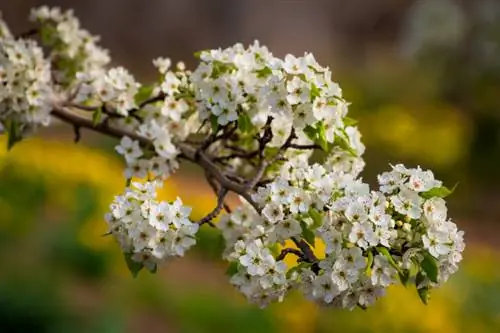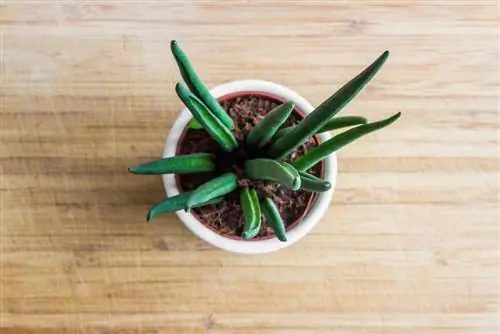- Author admin [email protected].
- Public 2023-12-16 16:46.
- Last modified 2025-01-23 11:22.
Read here in the commented orange tree profile information about height, flowering, fruit characteristics and winter hardiness. You can find out how to properly care for and overwinter orange trees here.
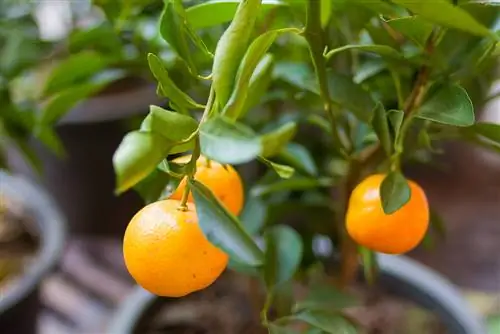
What are the characteristics of an orange tree?
An orange tree (Citrus sinensis) is an evergreen tree from Southeast Asia that can be cultivated in various sizes as a container plant. It blooms several times a year with white, fragrant flowers and bears edible orange fruits. Orange trees are not hardy and require cool, bright winter quarters as well as appropriate watering and fertilization.
Profile
- Scientific name: Citrus sinensis
- Genus: Citrus plants (Citrus)
- Synonym: orange tree, orange tree
- Origin: Southeast Asia
- Growth type: tree or small tree
- Leaf: evergreen, oval
- Flowers: five-fold, white, fragrant
- Flowering time: blooming several times
- Fruit: Cranberries
- Fruit properties: edible
- Winter hardiness: not hardy
- Use: potted plant, winter garden, houseplant
Growth height
In Southeast Asia and the subtropical growing regions, Citrus sinensis grow as majestic orange trees. Grafted cultivars remain significantly smaller and are ideal as representative pot plants. The following table provides a compact overview:
| Growth height | |
|---|---|
| Plantation Orange | 8 m to 10 m |
| Half trunk refined | 2 m to 3 m |
| Stems refined | 1, 50 m to 2, 50 m |
| Mini orange tree | 0, 50 m to 1, 50 m |
Depending on their height, orange trees display a well-formed, spherical crown. In the following video, admire magnificent specimens enjoying the summer sun in the large pot:
Video: Orange trees in front of a baroque backdrop
Bloom
In Europe, orange trees bloom from February to June. Grafted orange trees in pots bloom more often. The following characteristics characterize an orange blossom:
- Flower size: 2 cm to 4 cm in diameter
- Flower color: white
- Fragrance note: fruity-aromatic after orange
- flower ecology: hermaphrodite
- Position: in the leaf axils
Orange trees offer a fascinating spectacle when they bloom and fruit at the same time. Because the ripening period for oranges as container plants often extends into the next year, a feast for the senses of white, fragrant flowers, colorful, fragrant oranges and rich green, shimmering leaves unfolds in the dense treetop.
Fruits
The orange is the successful result of a cross between grapefruit (Citrus maxima) and mandarin (Citrus reticulata), which Chinese breeders succeeded in the early Middle Ages. If you own an orange tree in Central Europe, you don't have to buy well-traveled oranges in the store, but instead harvest fruit with these properties:
- Shape: 8 cm to 10 cm tall (mini orange fruit 2 cm to 4 cm)
- Ecology: fleshy berry fruit with thick skin
- Shell color: inside white, outside green, later orange
- Special feature: fragrant, ripe fruit peels
- Fruit: juicy, yellowish to orange with numerous seeds (cultivars often seedless)
- Fruit formation: self-fruitful (no second orange tree required)
- Harvest time: early varieties from mid-October, late varieties next spring.
Did you know that the green skin color is not a sign of ripeness? Because many consumers consider green oranges to be unripe and leave them on the shelf, the fruits of commercial varieties are degreened using ethylene gas. Under the influence of gas, green chlorophyll in the shell is destroyed and the associated loss of quality is accepted.
Winter hardiness
Like all citrus plants, an orange tree is not hardy. The minimum temperature is 5° Celsius. If the thermometer falls below 12° Celsius, the roots stop working. For this reason, orange trees in our latitudes have to overwinter indoors. A special section is dedicated to this important aspect in the care instructions that follow later.
Leaf
The evergreen backdrop for the flowers and fruits are the shapely leaves. These attributes characterize the leaf on the orange tree:
- Leaf shape: stalked, oval to lanceolate, pointed
- Color: dark green, shiny leather
- Arrangement: alternate-spiral
The property of evergreen does not mean that a leaf has eternal life. As a rule, an orange tree leaf renews itself every two to four years. In addition to the leaves, some orange trees have thorns up to 8 cm long on the angular branches. Knowledgeable breeders have weaned most cultivars off this reinforcement.
Planting an orange tree
As a hobby gardener, you have two options. You can buy an orange tree or propagate it and plant it yourself. The advantage of purchasing is that the orange trees are grafted and have swelling buds or are already blooming. In this case, you will of course miss out on the gardening success that comes with propagating on your own. The following short instructions explain the correct procedure:
Propagate
The easiest way to propagate an orange tree is with top cuttings. In spring or fall, take semi-woody, non-flowering cuttings with three to five promising buds. Please pluck off the leaves at the bottom. Plant a half-de-leafed cutting in well-drained, moist potting soil. Place the growing pot in a heated indoor greenhouse on the bright windowsill. At a humid temperature of 25° to 28° Celsius, the first roots will sprout after four to six weeks.
You can grow an orange tree from the seeds of fully ripe fruits. Allow the washed kernels to dry for 24 hours. Fill a seed container with coconut soil because it is well-drained and does not mold easily. Insert each seed about 2 centimeters deep into the substrate and water with a fine spray. The disadvantage of sowing orange seeds is that you have to wait up to 10 years for the first flowering period.
Plant in a pot
Plant the orange tree in a pot with an opening at the bottom for water drainage. Measure the pot size so that two to three fingers fit between the root ball and the edge of the container. As a substrate, use either special citrus plant soil or a mixture of peat-free potting soil, coconut fibers and expanded clay. This is how you plant an orange tree correctly:
- Cover the bottom of the bucket with expanded clay, pebbles or clay shards as drainage.
- Pour in a few handfuls of substrate and form a hollow.
- Unpotting orange trees from the purchased container or growing pot.
- Maintain previous planting depth.
- Plant the root ball so deep that a 3 cm high watering edge is created.
Water the planted orange tree thoroughly until the saucer fills with water. After 15 minutes, pour away the excess water to prevent waterlogging.
Location
Most of the year your orange tree wants a location with these basic conditions:
- From the end of March/beginning of April to October/November outside on the balcony, terrace or sunk into the bed with the pot.
- Full sun to shaded location.
- Preferably protected from wind and rain.
- Extra tip: set up the pot so that it cannot tip over.
Cultivation as a houseplant is possible in very bright living rooms on the south side of the house or in the light-flooded winter garden.
Excursus
Dream Team Chinotto and Orange Trees
Two closely related citrus plants give you a contrasting taste program. Chinotto (Citrus myrtifolia var. Citrus aurantium) bears fruit with a bitter, refreshing taste. The Chinotto fruit enjoys worldwide fame as the main ingredient in the legendary soft drink. On the other hand, you can enjoy juicy, sweet fruits from the orange tree freshly picked. The two pot beauties agree on undemanding care.
Care for the orange tree
An orange tree is easy to care for. The mainstays of the care program are watering as needed, balanced fertilization and correct wintering. Occasional cutting and repotting rounds off the pot culture perfectly. When an orange tree loses leaves, pests are often the cause. You can read important tips about the best orange tree care here:
Pouring
Citrus plant experts can talk for hours about proper water supply. We have everything you need to know in brief for you to read. This is how you water an orange tree in an exemplary manner at any time of the year:
- Watering water: Watering is done with tap water, which may contain lime, or collected rainwater.
- When to water?: Water promptly as soon as the top substrate layer has dried.
- What time of day do you water?: Ideally before sunrise (never in direct sunlight).
- How to water?: Let the water from the spout slowly run onto the root disk until the saucer fills up.
- Extra tip: Regular spraying of the leaves with soft water is very beneficial to the orange tree.
Experienced citrus gardeners check the current water requirements using a finger test. If you don't want to rely on your instinct, use a moisture meter.
Fertilize
Nutrification is easy. An orange tree is fertilized weekly from February to October. Add a liquid fertilizer (€6.00 at Amazon) for citrus plants to the irrigation water according to the manufacturer's instructions. Water before and after with clear water to protect the roots from salinity.
Wintering
An orange tree should overwinter frost-free, cool and bright. You can read what these criteria mean for successful wintering in this section:
- Putting away: before the first frost
- Winter in a cool place: at temperatures of 5° to 10° Celsius
- Winter brightly: ideally at 1500 lux (lumen value per m²) for 8 hours daily
- Winter quarters: cold winter garden, bright staircase, unheated bedroom, winter tent with frost monitor
- Winter care: water sparingly, do not fertilize, check for pests
The wintering period in most regions of Germany extends from the end of October/beginning of November to the beginning/mid of April.
Cutting
An orange tree in a pot forms a round crown even without cutting. Occasional trimming and thinning is beneficial for compact, flower-rich growth. Because orange trees tolerate pruning well, you can use the scissors at any time of the year. Cut off awkward and dead branches. Cutting is done on buds. With this cutting technique, you place the scissors 3-5 mm above an eye or leaf.
If you grow an orange tree yourself, training and development pruning must be completed to ensure a well-formed crown. There is a detailed tutorial dedicated to this pruning challenge using the example of the lemon tree, which you can read here.
Repotting
Young orange trees grow quickly and are repotted annually. Older potted oranges take things slower. You can tell from two clues whether you should repot the potted plants: Roots grow out of the opening in the bottom. The tree crown is larger than the diameter of the pot. The best time is in spring, when orange trees leave their winter quarters.
Pests
Overwintering that is too warm makes your orange tree susceptible to pest infestation. Dry heating air with temperatures well above 12° Celsius and a lack of light cause spider mites and scale insects to appear. A change of location to the bright, cool winter quarters and regular spraying of the leaves frees your orange tree from the rabble.
Popular varieties
The most beautiful orange trees as houseplants introduces you to the following selection of varieties:
- Navelina: the well-known Navel orange for pot cultivation with 10 cm large, juicy, sweet, seedless fruits.
- Valencia late: late premium variety, most popular orange tree bears fragrant flowers, green and golden oranges at the same time.
- Tarocco foliis variegatis: delights with variegated, evergreen leaves and green-striped oranges.
- Quattro Stagioni: brilliant four-season orange tree that blooms and produces fruit all year round.
- Vaniglia Sanguigno: early variety whose white flowers bloom from March to May and turn into sugary, pink mini-oranges.
FAQ
When is an orange tree allowed on the balcony?
The local weather conditions determine when you can put your orange tree on the balcony. From April onwards, temperatures in most regions of Germany exceed the minimum of 5° Celsius, even at night. Now you can clear out an orange tree onto the sunny balcony. To protect against unexpected night frosts, a winter fleece should be ready by mid-May.
Are the fruits of the mini orange tree edible?
Every orange tree bears edible fruit. This applies equally to the majestic plantation tree with a height of 10 meters and the 50 centimeter mini orange tree.

